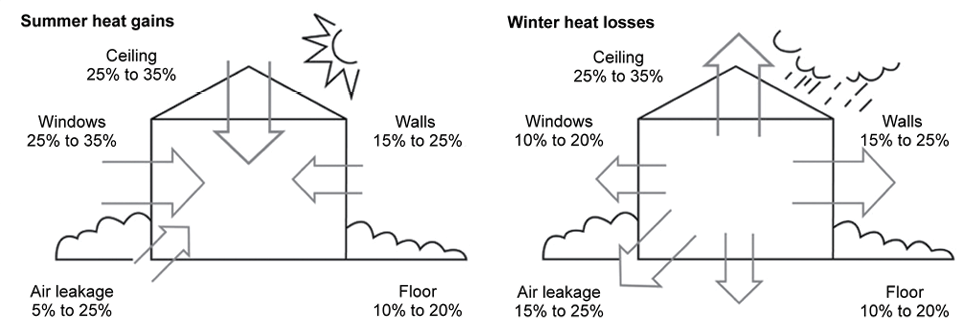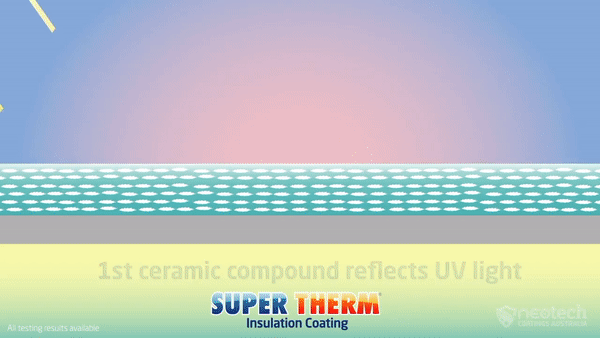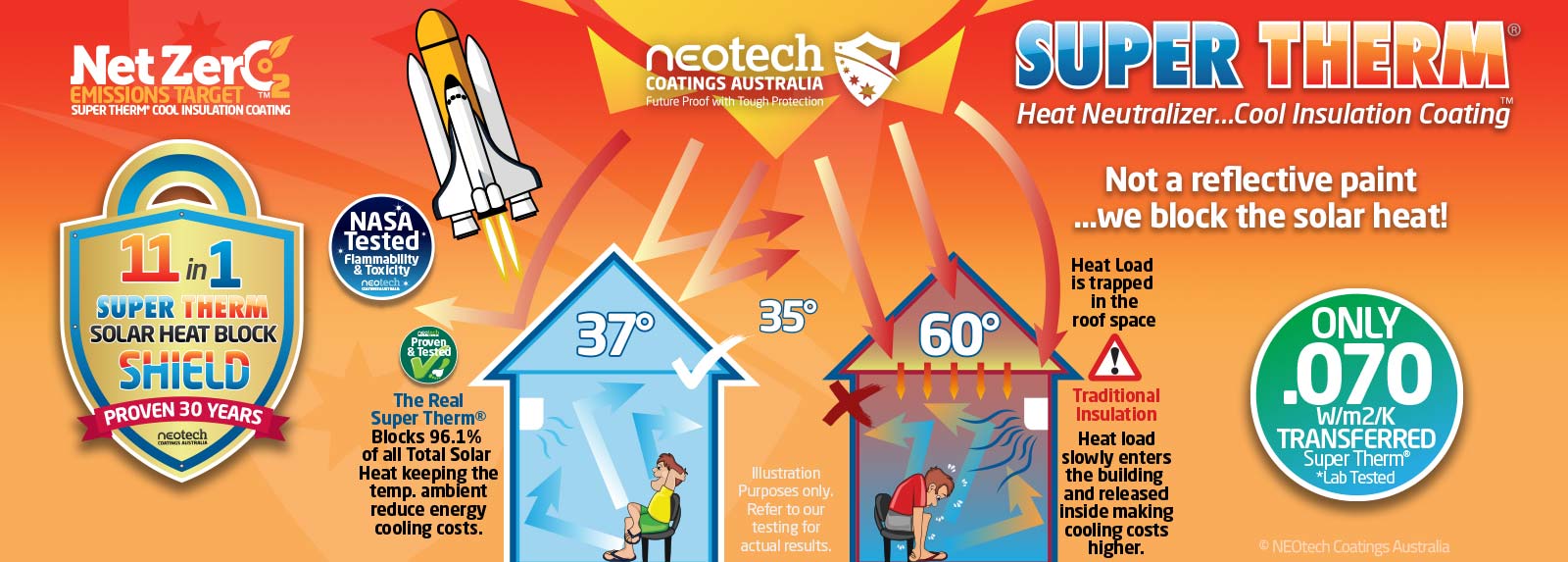Why is your home hot at night?
There are many reasons why your home is hot at night. Heat can come from internal appliances as one source or from humans. Heat can also penetrate through walls, windows and even the slab.
One of the most overlooked and primary sources of heat in the home at night is from your roof space where heat is stored and the bulk insulation creates thermal inertia – slowing the heat’s release from the day at night.
YourHome.gov.au states that between 25-35% of heat into the home in summer is through the roof. If the roof space has all that heat from the day it contributes to heat at night.
The solar heat from the sun during the day penetrates your zincalume and galvanised sheets or is stored in your roof tiles and transferred to the roof space. This keeps the radiation “trapped” inside the house. The bulk insulation slows the trapped heat from the day. Due to thermal dynamics, once the sun has gone down that heat is attracted to the coolest part of the environment, your home where the air conditioning is running.
Science Direct state “Thermal inertia can be defined as the ‘property of a material that expresses the degree of slowness with which its temperature reaches that of the environment’ Ng et al. 2011. However, the definition that probably best expresses the effects it causes in an enclosure is the ‘capacity of a material to store heat and to delay its transmission’, Ferrari”.
Like a full bucket of water, the overflowing heat is then transferred through the ceiling and continues to conduct through. You may even feel this heat building up overhead. As this continues to heat your home, this stops your home from cooling down overnight and can make it very uncomfortable inside.
Many people believe that just bulk insulation is enough and that’s all you can do for your home and it’s great at insulating. However, there’s many test results that prove that dust, age, compression and moisture deteriorate the insulation over time ultimately reducing the effectiveness…particularly fibreglass insulation. The problem is out of sight is out of mind.
Super Therm® blocks 96.1% of solar heat and saves up to 20-50% (Industry tested) in energy use for over 30 years

Bulk insulation traps heat
Bulk fibreglass insulation in your roof (R5 or above) and walls (R2.8 or above) can dramatically reduce summer heat entering your home and winter heat leaving your home. The R value of insulation is a measure of its resistance to heat flow. The higher the R value the thicker the insulation.
An article by Edoardo Verduci on insulation properties states “as the temperature increases or humidity level increases, the R-value of a product decreases, meaning it’s less effective at slowing down the transfer of heat. Real world situations can compromise the R-value of traditional insulation substantially (imagine that traditional insulation can lose 35% of its R-value when as little as 1.5% humidity is introduced).”
If you live in a two storey home, you’ll be aware that the upstairs living areas are normally much hotter than downstairs. The stored radiant heat from the roof space will cause the second story to remain hot well into the night along with heat moving up from the ground floor. Many people are starting to include reflective barriers or sarking which are meant to reflect radiant heat and keep the roof space cooler during the day, however once the heat has penetrated the roof substrate, i.e. the metal or tiles then it’s already inside the home. Sarking cannot reflect heat once it has become conductive inside the home. It’s another form of bulk insulation aimed to reduces the flow yet what it does is cover up condensation and hides the corroded sheets underneath.
Dark roofs suck in the heat
What makes things even worse are dark roofs. Black is hot; white is cool. Many people think a dark roof looks great…and they do but they are paying the price with a 30% increase of roof temperature inside their home as black is the perfect emitter of heat. So if you have a two story home, with a black or dark roof you’ll be increasing the temperature to over 70°C on a high 30°C day and it’s even worse with tiles. Not to mention, the bulk insulation you do have in your roof space has only ever been tested at 23°C in the 1970s and never field tested.
Naturally this makes your home hot…real hot and then the air conditioning needs to run extremely hard to keep you cool. Air conditioners are not designed to operate over 48°C day and every degree over 22°C your air conditioner is set to add more cost to your power bill. Dr Robert Simpson, energy-efficiency specialist at Ausgrid says “set the aircon between 23˚C and 26˚C – each degree of extra cooling can add 10% to your running costs.”
High cost to run your air conditioner
Con Edison the New York electricity company supplies more than 10 million people in the New York area. It’s grid, with 62 power substations and more than 130,000 miles of power lines and cables across New York City and Westchester County, can deliver 13,400MW every second. This is roughly equivalent to 18m horsepower. It’s fair to say they understand the needs of energy consumption in major cities. There are net energy consumption gains as Con Edison research from New York stated “keep your thermostat set at 78°F (25.5°C) when your building is occupied…turning down the thermostat to 75°F (23.8°C) costs 18% more, and 72°F (22.2°C) costs 39% more!”
Research from the UniSA by Dr. John Pockett on Cool Roofs and Heat Reflective Paints states the cooling efficiency for air conditioners is about half their maximum capacity on very hot days. This requires much more electricity to get the same cooling effect and is one of the reasons why their modelling shows more effectiveness for light rather than dark roofs compared with modelling based only on the first step, heat flow into conditioned spaces.
Compounding issues are your air conditioning ducts in the roof space. If the temperature is reaching over 70°C, the cool air passing through the ducts is under enormous heat pressure. This means your air conditioner is again working harder to keep cool and consuming much more power and is inefficient. So heat is attacking the unit outside and through the roof to deliver half its effectiveness to your home costing you and the environment more.
As part of the big picture all of this is adding to the urban heat island effect and contributing to growing CO2 emissions and global warming.
The hottest place in the country last week was Onslow in Western Australia, where the mercury reached a scorching 50.7 degrees, equalling the record for the highest temperature ever recorded in the southern hemisphere. Climate scientists argue such heatwaves are becoming more likely and extreme because of climate change. Christopher Lewis reports.
What to do about a hot home?
Adding a light coloured roof to your home helps reflect heat right where it’s beating down on it. Adding a Cool Roof to your home is like being under a shady tree. In fact a Super Therm® Cool Roof does more than block 96.1% of the solar heat from the sun, it also:
- Lasts well over 20 years – no cracking, flaking or peeling
- Dramatically reduces energy consumption and bills
- Improves human and animal comfort
- Single coat application (no priming)
- Easy to apply, safe and water based
- Works while dirty
- Reduces CO2 consumption
- Fireproof class ‘A’ rating; won’t burn
- Blocks 50-68% sound
- Prevents thermal contraction and extends roof life
- Tested and blocks 99.5% infrared heat
- Proven globally for over 30+ years
- Only ceramic solar heat block coating developed with NASA
- Over 7 million square metres applied across Japan
Cool Roofs are the next generation of heat block paints. Governments and companies around the globe are turning to cool roofs and the Tesla of Cool Roofs performance is Super Therm®.
Blocking the initial heat load is the “key” to controlling
heat load and flow into or out of a building structure!











